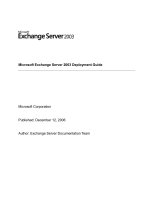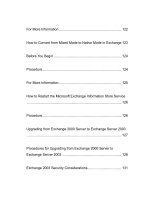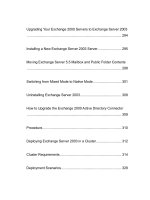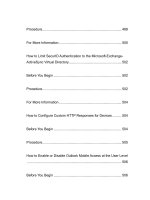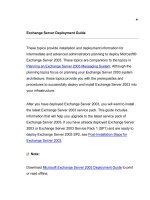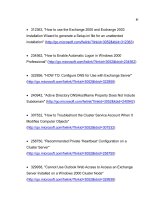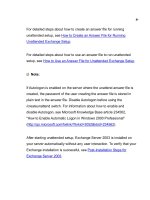Microsoft Exchange Server 2003 Deployment Guide- P5 pptx
Bạn đang xem bản rút gọn của tài liệu. Xem và tải ngay bản đầy đủ của tài liệu tại đây (214.4 KB, 10 trang )
41
Exchange Server Deployment Guide
These topics provide installation and deployment information for
intermediate and advanced administrators planning to deploy Microsoft®
Exchange Server 2003. These topics are companions to the topics in
Planning an Exchange Server 2003 Messaging System. Although the
planning topics focus on planning your Exchange Server 2003 system
architecture, these topics provide you with the prerequisites and
procedures to successfully deploy and install Exchange Server 2003 into
your infrastructure.
After you have deployed Exchange Server 2003, you will want to install
the latest Exchange Server 2003 service pack. This guide includes
information that will help you upgrade to the latest service pack of
Exchange Server 2003. If you have already deployed Exchange Server
2003 or Exchange Server 2003 Service Pack 1 (SP1) and are ready to
deploy Exchange Server 2003 SP2, see Post-Installation Steps for
Exchange Server 2003.
Note:
Download Microsoft Exchange Server 2003 Deployment Guide to print
or read offline.
42
Introduction to the Exchange Server 2003 Deployment Guide
These topics provide installation and deployment information for
intermediate and advanced administrators planning to deploy Microsoft®
Exchange Server 2003. These topics are companions to the topics in
Planning an Exchange Server 2003 Messaging System
( Although those topics
focus on planning your Exchange 2003 system architecture, these topics
walk you through the prerequisites and procedures to successfully deploy
and install Exchange Server 2003 into your infrastructure.
Whether you are deploying a new Exchange Server 2003 messaging
system or upgrading from a previous Exchange version, these topics will
guide you through the deployment process and provide deployment
recommendations, including recommendations on how to configure your
Exchange 2003 organization to run in native mode. These topics also
provide instructions about how to use Exchange Server Deployment
Tools. Exchange Server Deployment Tools provide you with utilities and
wizards to help verify that your organization is in a healthy state before
you deploy Exchange 2003.
43
Note:
Your Exchange Server 2003 deployment plan should reflect your
understanding of how Exchange and Microsoft Windows Server™
operating systems interoperate. It should encompass the relationships
between Windows Server 2003 and Microsoft Windows® 2000 Server
sites and domains, domain controllers, global catalog servers, and
Exchange 2003 administrative and routing groups. The person who
designed your Windows Server 2003 or Windows 2000 deployment
may be less familiar with Exchange. Keep this in mind as you plan
your Exchange 2003 deployment, because you may need to fine-tune
Windows for the new messaging system.
What Will You Learn from These Topics?
These topics provide conceptual and procedural information about the
following:
Installing your first Exchange Server 2003 computer into your
organization (see Installing New Exchange 2003 Servers).
Upgrading your existing Exchange 2000 native organization to
Exchange Server 2003 (see Upgrading from Exchange 2000 Server to
Exchange Server 2003).
44
Installing your first Exchange Server 2003 computer into your existing
Exchange Server version 5.5 site, and migrate your mailbox data and
public folder information to your Exchange Server 2003 computer (see
Migrating from Exchange Server 5.5 to Exchange Server 2003).
Using the Migration Wizard and Inter-Organization Replication Tool to
move your mailbox and public folder data from one Exchange
organization to another (see Inter-Organizational Migration to Exchange
Server 2003).
Upgrading your mixed-mode Exchange 2000 and Exchange 5.5
organization to Exchange Server 2003 (see Upgrading from Mixed
Exchange 2000 and Exchange 5.5 Organizations).
Configuring your Exchange 2003 organization to run under Microsoft
Windows Clustering (see Deploying Exchange Server 2003 in a Cluster).
Configuring your client computers to use new Exchange features,
including Cached Exchange Mode, Exchange ActiveSync® and Microsoft
Outlook Mobile Access (see Configuring Exchange 2003 for Client
Access).
Synchronizing multiple Exchange 2003 forests, including how to
synchronize the global address list (GAL), configure cross-forest mail
45
flow, and use Migration Wizard to move users' mailboxes (see
Synchronizing Multiple Exchange 2003 Forests).
Meeting deployment requirements for consolidating your remote
Exchange sites, including information about using the Exchange Server
Deployment Tools to help with your consolidation and instructions about
how to remove your Exchange servers from a remote site (see
Consolidating Sites in Exchange 2003).
Verifying that your installation was successful by using the
Exchange 2003 setup log and the Windows Event Viewer (see Post-
Installation Steps for Exchange Server 2003).
Running Exchange Setup to uninstall Exchange Server 2003 (see How
to Uninstall Exchange Server 2003).
Running the Exchange Server Deployment Tools to aid you in
accomplishing many of the preceding tasks.
Note:
It is recommended that you first read Improvements to Exchange 2003
Setup, and then read the appropriate topics that relate to your
deployment plan. You can then read Configuring Exchange 2003 for
46
Client Access for information about how to configure your clients for
Exchange Server 2003 access.
Who Should Read These Topics?
These topics are designed for information technology professionals who
are responsible for deploying Exchange messaging systems for their
companies. Such professionals may be in the following roles:
Systems administrators Those people who are responsible for
planning and deploying technology across Windows and Exchange
servers.
Messaging administrators Those people who are responsible for
implementing and managing organizational messaging.
What Technologies Do These Topics Cover?
These topics provide several deployment scenarios, including installing
new Exchange 2003 organizations, upgrading your Exchange 2000
organization, and installing a new Exchange 2003 computer into your
Exchange 5.5 site and migrating your Exchange 5.5 mailboxes and public
folders. For detailed information about specific technologies such as the
Microsoft Active Directory® directory service, Microsoft Office
47
Outlook 2003, or Microsoft Office Outlook Web Access 2003, refer to
Windows, Outlook 2003, and Exchange Server 2003 product
documentation.
For More Information
The following resources provide valuable information regarding
deployment concepts and processes.
Web Sites
Exchange Server TechCenter
(
Downloads for Exchange 2003
(
MSDN® (
Microsoft Identity Integration Server (MIIS) 2003
(
48
Exchange Server 2003 Topics
What's New in Exchange Server 2003
(
Planning an Exchange Server 2003 Messaging System
(
Exchange Server 2003 Administration Guide
(
Exchange Server 2003 Security Hardening Guide
(
Technical Articles
Deploying Microsoft Exchange 2000 Server Clusters
(
Best Practice: Active Directory Design for Exchange 2000
(
49
Disaster Recovery for Microsoft Exchange 2000 Server
(
Using Microsoft Exchange 2000 Front-End Servers
(
Microsoft Identity Integration Server 2003 Scenarios
(
Why Service Packs are Better Than Patches
(
Tools
Exchange Server Deployment Tools
(
Inter-Organization Replication Tool
(
Active Directory Migration Tool (ADMT), version 2.0
(
50
Microsoft Baseline Security Analyzer (MBSA)
(
Resource Kits
Microsoft Exchange 2000 Server Resource Kit
(
You can order a copy of Microsoft Exchange 2000 Server Resource Kit
from Microsoft Press® at
Microsoft Windows 2000 Server Resource Kit
(
You can order a copy of Microsoft Windows 2000 Server Resource Kit
from Microsoft Press at
Microsoft Knowledge Base Articles
325044, "HOW TO: Troubleshoot Virtual Memory Fragmentation in
Exchange 2003 and Exchange 2000"
(
